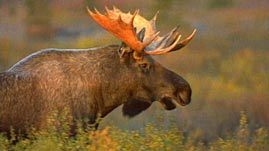Teachers' Domain - Digital Media for the Classroom and Professional Development
User: Preview

Source: Alaska Native Heritage Center, and Education through Cultural and Historical Organizations (ECHO)
This video adapted from the Alaska Native Heritage Center focuses on the cycle of seasons that guides the traditional Alaska Native subsistence way of life. As the seasons change and the available resources change, so do Alaska Native peoples' hunting and gathering activities. Recognizing the interdependence of life in nature, Alaska Native groups have respect for the land, sea, and animals. They also demonstrate respect for the Elders living among them. The integration of technology, including snowmobiles and GPS, into their subsistence activities demonstrates a blending of tradition and modern ways.
For Alaska Native peoples and many other indigenous peoples around the world, subsistence living is a way of being and relating to the world that represents an intricate bond between humans and the land. It is more than the sum of activities such as fishing, hunting, making shelter, and preserving food. Rather, traditional Native life depends on reading nature's cycles and signs, such as the cycles of the moon, and using that knowledge to use what nature provides. It is living life in a way that is sustainable and that honors one's ancestors, the land, and the sea. It is important to health, culture, and identity. Subsistence living is centered on customs, and its existence and integrity is mandated by law.
Traditionally, subsistence activities follow the fish, wildlife, and plants that are available at different times of the year. These resources differ across Alaska, largely according to whether a community is situated along the coast or in the interior, to the north or to the south. No matter what is being harvested in a given season—salmon, seaweed, roots, or caribou—daily effort is required to live from the land and sea. The techniques and knowledge needed for subsistence living are passed down from generation to generation through stories of the Elders and life experiences.
Subsistence communities abide by certain principles in order to preserve nature's abundance. Primary among these principles of stewardship is never taking more from the sea or the land than what can be used. At the same time, because certain fish, wildlife, and plants are only seasonally available, Alaska Native peoples are aware of the importance of getting enough to last the year. While individuals who can afford them may freeze their foods in modern-day freezers, many still use permafrost, the frozen soil that underlies most of Alaska, as a natural source of refrigeration to preserve meats and other perishable foods. Other methods of food preservation, such as smoking, salting, and drying, are also part of the culture and traditional knowledge of Native peoples.
Despite long-standing traditions, Alaska Native peoples are forced to rethink subsistence living in the face of a warming climate. While some communities may be able to continue their traditional way of life by moving with the animals they depend on, other communities may be forced to abandon subsistence altogether as climate factors cause migratory patterns to shift farther away from the villages and some animals to disappear completely. Melting ice is another factor that is forcing costly fortification or relocation of some subsistence communities. The ice pack that used to protect the coastline is absent, making the coastline susceptible to storm- and wave-caused erosion. As permafrost thaws, erosion and subsidence are ruining houses, roads, and other built structures.
 Loading Standards
Loading Standards Teachers' Domain is proud to be a Pathways portal to the National Science Digital Library.
Teachers' Domain is proud to be a Pathways portal to the National Science Digital Library.
